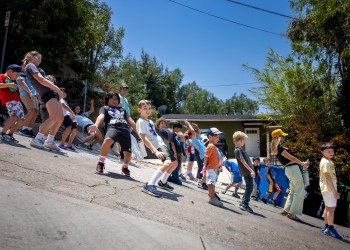On the surface, Proposition 36 on the fall ballot seems like it should be an absolute slam-dunk. That’s the initiative seeking to change California’s landmark Three-Strikes-and-You’re-Out law, the 1994 measure imposing an automatic 25-years-to-life sentence on most three-time felons.
Proposition 36 seeks to change that just a bit, requiring that any third offense yielding the draconian sentence be a violent one. Its supporters say this would produce quick reductions in sentence for about 3,000 current convicts whose third strikes were sometimes as trivial as shoplifting or simple theft, crimes that are often misdemeanors but can be lifted by prosecutors to third-strike status if they wish.
Pass this measure and those 3,000 prisoners will quickly have their long sentences reduced, freeing them and saving the state a cool $47,000 each every year, or a total of $141 million per year. That’s nice to save in a day when California regularly runs multi-billion dollar budget deficits.
But wait a minute, says Mike Reynolds, the Fresno photographer whose daughter’s 1992 murder while she resisted a purse-snatcher was one proximate cause spurring both the Legislature and voters to adopt the current compulsory sentencing system, since adopted by 19 other states.
“We would see a whole new level of offender released,” says Reynolds. “These people had at least two other violent felonies before they got their third strike, no matter what it was for.”
He also insists that any savings would be illusory. “This law has saved $57 billion in crimes that were not committed, but would have been otherwise, according to the U.S. Department of Justice. And that doesn’t even account for all the murders and rapes that have not happened in the 18 years we’ve had this law.”
Reynolds is convinced letting 3,000 third-strikers (more than one-third of the 8,000-odd current ones) out of prison would lead to a new wave of serious, violent crime.
That’s not what the research shows, according to the Three Strikes Project, a Stanford University effort that’s behind Proposition 36. Some three-strikes inmates have long been held on the presumption that misdemeanors are often precursors of major offenses committed later by the same people. But the Stanford project maintains no credible academic study has ever supported this conclusion.
Supporting this assertion is the fact that violent crime rates are slightly higher in other parts of the state than in Los Angeles and San Francisco counties, where district attorneys past and present have long acted as if Proposition 36 were already in place. Those prosecutors include 2010 Republican attorney general candidate Steve Cooley in Los Angeles and George Gascon (also a former deputy police chief in Los Angeles) and Kamala Harris (the current attorney general) in San Francisco.
Statewide, crime rates are close to 50 percent lower overall than before Three Strikes passed, and Reynolds maintains there’s a clear cause and effect at work here.
Michael Romano, the Stanford professor who founded the Three Strikes Project which for years has also helped appeal harsh sentences against nonviolent three strikers, has claimed only 4 percent of persons serving life terms for nonviolent third offenses are likely to commit new crimes if released, about one-fifth the rate for inmates released from the general prison population.
For sure, there’s one thing Proposition 36 would not solve: It would not do much about the reality that California prisons have become a vast system of geriatric homes, as prisoners with life terms cannot be released upon reaching their 60s and 70s, when committing violent crime is rare.
Releasing most elderly convicts could save the state far more than the $141 million Proposition 36 would produce, especially since older inmates are the most likely to need expensive medical care.
The vast majority of the approximately 3,000 prisoners Proposition 36 would let go do not fall into the senior citizen category. Many were sentenced while in their 20s, which puts them in their late 40s or early 50s even when their minimum 25-year-terms are up (often 20 years with good behavior). Those people remain in an age category where violent crimes are a serious possibility.
Still, there is no doubt that holding some three-strikers is both unnecessary and often a waste of big money. The problem comes in predicting which three-time losers who might be released will commit yet another crime – an imprecise science at best. This makes it clear passage of Proposition 36 would produce at least some additional crime, even if that comes at the low rate Romano claims.
That, of course, has to be weighed against the flimsiness of the third strikes that put some of today’s prisoners back behind bars for life, or close to it.
One good thing about this initiative fight is that it’s being waged on the battleground of ideas, not via TV commercials. That’s because neither the yes nor the no side has enough money right now to stage a major campaign. Ideally, that’s how things should be for all ballot propositions.


























